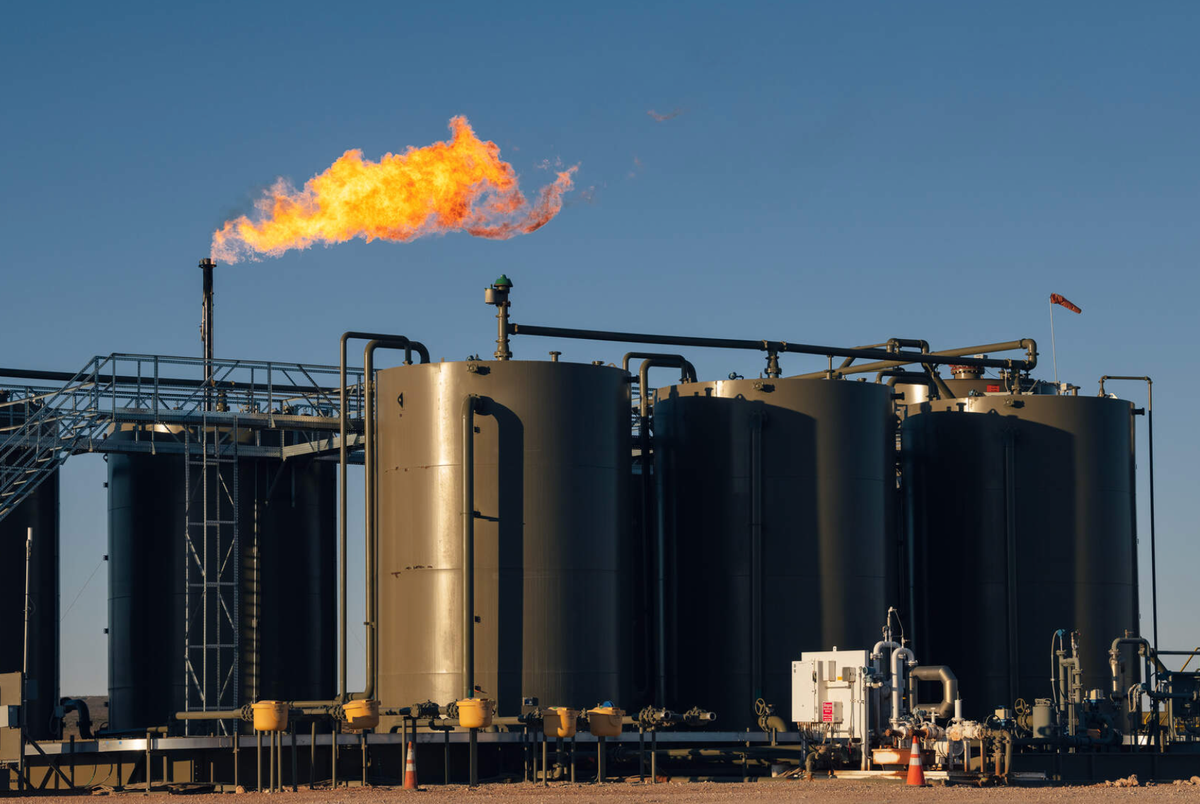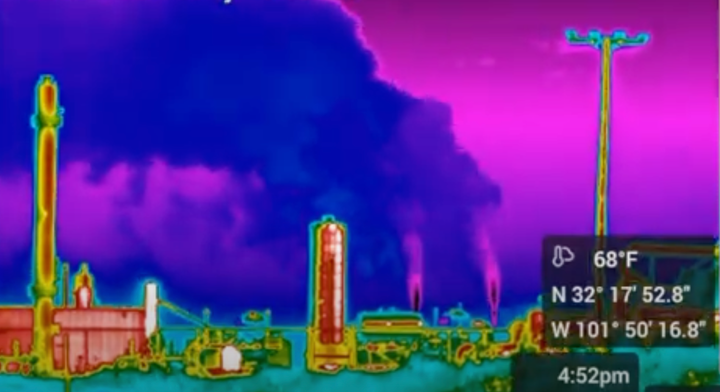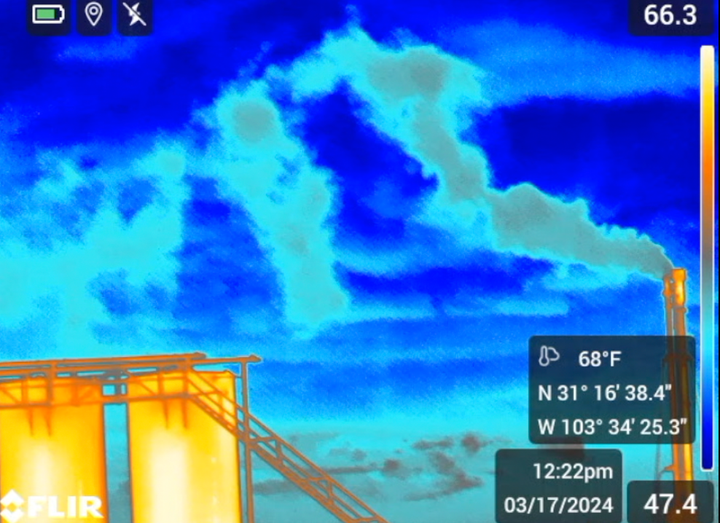New Satellite Data Reveals Dangerous Methane Emissions in Permian Region
New research based on satellite data confirms that the oil and gas industry in the Permian region of Texas and New Mexico is leaking record amounts of methane.

New research based on satellite data confirms that the oil and gas industry in the Permian region of Texas and New Mexico is leaking record amounts of methane. The new research published in the journal Science Advances found that methane emissions in the Permian Basin were equivalent to 3.7 percent of the total methane produced by the oil and gas industry there.
In December DeSmog reported on the work of Robert Howarth, a biogeochemist at Cornell University, who has been studying the methane emissions of the oil and gas industry. Howarth’s latest research estimated that 3.4 percent of all natural gas produced from shale in the U.S. is leaked throughout the production cycle, which appears to be confirmed by this new research.
Methane is a powerful greenhouse gas and makes up approximately 90 percent of what is known as natural gas. It’s a major contributor to global warming.
The oil and gas industry has long tried to sell the idea of natural gas, which is, again, primarily methane, as a clean energy climate solution. However, with a leakage rate of 3.7 percent, natural gas is actually worse for the climate than coal.
Advertisements for natural gas from the industry trade group the American Petroleum Institute have claimed, “Thanks to natural gas, the U.S. is leading the way in reducing emissions.”
This new satellite data confirms that simply isn’t the case. When the methane leaks from oil and gas production are taken into account, natural gas is unquestionably a dirty fossil fuel.
This new research also helps explain why methane emissions rose at such a high rate in 2019.
Satellites Can Finally Hold the Oil and Gas Industry Accountable
One of the reasons the oil and gas industry was so successful at climate denial in the beginning was that the impacts of climate change were mostly theoretical or far removed from daily life. However, once the impacts of climate change became impossible to deny — like more intense hurricanes in North Carolina or sunny day floodingin Florida — it became harder to deny the reality of climate change.
Methane is invisible and odorless. In the past measuring the amount of methane emissions from oil and gas has relied on industry self-reporting. It is easy to deny something that no one can see or smell. That began to change with the work of people like Sharon Wilson at Earthworks who was able to use a special infrared camera that could see the methane as it leaked and was vented from oil and gas operations.
Now with the availability of satellite data, the game has changed. This first became evident late last year when scientists reported that a fracked gas well that blew out in Ohio, releasing methane into the atmosphere for 20 days, was one of the largest methane leaks in U.S. history. The well was owned by ExxonMobil subsidiary XTOEnergy, and according to The New York Times, Exxon initially said it could not determine the amount of gas that had leaked.
New data from satellites quantified the amount of methane released from that well blowout, and it now appears that event may have been the beginning of accurate readings of methane leaks from individual wells and oil fields.
History of Underestimates and Self-Regulation
Prior to satellite readings, the Environmental Protection Agency (EPA) relied on industry self-reporting to determine the levels of methane emissions from oil and gas, so it is no surprise that the numbers were lower than satellites have found.
In 2006 when the oil and gas industry was strategizing how to sell natural gas as a climate solution, it was well aware of the problem of methane emissions. What has played out since then is under-reporting of emissions by the industry, combined with misleading ad campaigns to sell natural gas as clean energy.
This new study confirms a trend in recent research showing a consistent underestimation of methane emissions by the EPA and industry.
This month new research from the University of Michigan found that offshore oil platforms are emitting twice the level of methane estimated by the EPA.
Last month new research revealed that methane emissions from coal mines are likely also double previous estimates and may be responsible for more emissions than the oil and gas industry.
As all of this alarming research is revealing the scope of the methane problem related to the fossil fuel industry, the Trump administration has rolled back Obama-era methane regulations for the oil and gas industry, and Exxon is proposing voluntary regulations. With the industry’s history of voluntary self-reporting of methane emissions, that is an approach that is unlikely to address the problem.
Satellites Confirm Natural Gas Is a Major Contributor to Climate Change
Thanks to satellites we now know that oil and gas operations in the Permian region have contributed greatly to the growing methane emissions problem. Unfortunately the current financial collapse of the U.S. oil and gas industryis likely to result in even higher short-term emissions as regulations are lightened and companies have no resources or financial incentive to control the problem while they face bankruptcy.
“Unlike carbon emissions, methane emissions don’t decrease when the world’s economy slows down,” Poppy Kalesi, policy director for European oil and gas at the Environmental Defense Fund told Bloomberg Law. “With lower oil and gas prices, we already see efficiency savings in companies, which means that they might be more relaxed about their environmental protocols.”
An industry that has underreported methane emissions in the past is unlikely to care about controlling emissions while in a financial death spiral.
The oil and gas industry has covered up and denied the problem of methane emissions — just as it did with climate science — but with these new satellite readings finally providing real data that confirms the work of scientists like Robert Howarth, we now can confirm that natural gas is not a climate solution. In reality, gas is a major part of the problem.
Main Image: Oil and gas operations in the Permian. Credit: Justin Hamel © 2020
This article originally appeared on DeSmog.



Comments ()